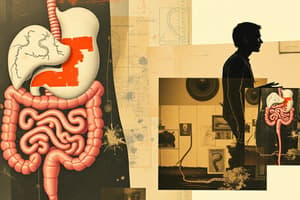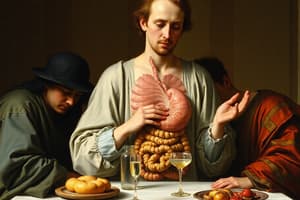Podcast
Questions and Answers
What is the primary role of motility in the gastrointestinal tract?
What is the primary role of motility in the gastrointestinal tract?
- Regulating enzyme activity
- Initiating the absorption of nutrients
- Controlling blood flow to the digestive organs
- Mixing food with digestive juices and moving it forward (correct)
Which type of muscle control is responsible for the contractions in the walls of the gastrointestinal tract?
Which type of muscle control is responsible for the contractions in the walls of the gastrointestinal tract?
- Involuntary control (correct)
- Cognitive control
- Voluntary control
- Reflexive control
Which motility type is characterized by forward movement of contents through the GI tract?
Which motility type is characterized by forward movement of contents through the GI tract?
- Reflux
- Contraction
- Segmentation
- Peristalsis (correct)
What structural feature is consistent throughout the gastrointestinal tract wall?
What structural feature is consistent throughout the gastrointestinal tract wall?
What system is primarily responsible for regulating digestive functions independently of the central nervous system?
What system is primarily responsible for regulating digestive functions independently of the central nervous system?
What effect do sympathetic nerve fibers have on gastrointestinal (GI) tract motility?
What effect do sympathetic nerve fibers have on gastrointestinal (GI) tract motility?
Which of the following is a role of GI peptides in digestion?
Which of the following is a role of GI peptides in digestion?
The parasympathetic nervous system generally affects gastrointestinal functions by:
The parasympathetic nervous system generally affects gastrointestinal functions by:
Which of the following hormones is NOT classified as a GI peptide?
Which of the following hormones is NOT classified as a GI peptide?
What function do neurocrines play in the regulation of the digestive system?
What function do neurocrines play in the regulation of the digestive system?
During which physiological state is the sympathetic nervous system primarily activated to influence digestion?
During which physiological state is the sympathetic nervous system primarily activated to influence digestion?
Which type of muscle contraction is primarily influenced by gastrointestinal peptides?
Which type of muscle contraction is primarily influenced by gastrointestinal peptides?
Which of the following components primarily influences the secretion of fluids and electrolytes in the GI tract?
Which of the following components primarily influences the secretion of fluids and electrolytes in the GI tract?
What is the primary function of acetylcholine (ACh) in the enteric nervous system?
What is the primary function of acetylcholine (ACh) in the enteric nervous system?
What effect does norepinephrine (NE) have on the smooth muscle of the GI tract?
What effect does norepinephrine (NE) have on the smooth muscle of the GI tract?
Which neurotransmitter is primarily responsible for increasing both pancreatic and intestinal secretion?
Which neurotransmitter is primarily responsible for increasing both pancreatic and intestinal secretion?
What is the primary function of substance P in the GI system?
What is the primary function of substance P in the GI system?
What is the role of enkephalins in the enteric nervous system?
What is the role of enkephalins in the enteric nervous system?
Which neurotransmitter is specifically associated with gastric secretion regulation?
Which neurotransmitter is specifically associated with gastric secretion regulation?
The contraction of which type of muscle in the GI tract is influenced by acetylcholine (ACh)?
The contraction of which type of muscle in the GI tract is influenced by acetylcholine (ACh)?
Neuropeptide Y primarily inhibits secretion in which part of the GI tract?
Neuropeptide Y primarily inhibits secretion in which part of the GI tract?
What is the function of pacesetter cells in the GI tract?
What is the function of pacesetter cells in the GI tract?
Which of the following neurotransmitters causes relaxation of the smooth muscle of the GI tract?
Which of the following neurotransmitters causes relaxation of the smooth muscle of the GI tract?
Which neurotransmitter co-secreted with ACh influences salivary secretion?
Which neurotransmitter co-secreted with ACh influences salivary secretion?
Which layer of the GI tract wall is primarily responsible for muscle contractions?
Which layer of the GI tract wall is primarily responsible for muscle contractions?
Which structure is not part of the enteric nervous system?
Which structure is not part of the enteric nervous system?
Which of the following best describes the role of the myenteric plexus?
Which of the following best describes the role of the myenteric plexus?
What type of muscle is primarily involved in the motility of the GI tract?
What type of muscle is primarily involved in the motility of the GI tract?
Which component is mainly responsible for regulating digestive functions autonomously?
Which component is mainly responsible for regulating digestive functions autonomously?
The submucous plexus is located within which layer of the GI wall?
The submucous plexus is located within which layer of the GI wall?
What role does the mucous membrane play in the GI tract?
What role does the mucous membrane play in the GI tract?
Which type of motility in the GI system is responsible for the rhythmic contractions that mix food?
Which type of motility in the GI system is responsible for the rhythmic contractions that mix food?
What is the primary structural function of the lamina propria?
What is the primary structural function of the lamina propria?
Flashcards are hidden until you start studying
Study Notes
Regulation of Digestive Function
-
Extrinsic Nerves
- Sympathetic Nervous System (SNS): Slows down GI tract secretion and motility. Activated during "fight or flight" response.
- Parasympathetic Nervous System (PNS): Increases motility and secretion.
-
GI Peptides
- Hormones, paracrines, and neurocrines that influence:
- Contraction and relaxation of smooth muscle walls and sphincters.
- Secretion of digestive enzymes.
- Secretion of fluids and electrolytes.
- Examples:
- Cholecystokinin (CCK):
- Gastrin:
- Secretin:
- Somatostatin:
- Hormones, paracrines, and neurocrines that influence:
Enteric Nervous System
- Neurotransmitters & Neuromodulators
-
Acetylcholine (ACh):
- Cholinergic neurons.
- Contracts smooth muscle in the GI wall.
- Relaxes sphincters.
- Increases salivary, gastric, and pancreatic secretions.
-
Norepinephrine (NE):
- Adrenergic neurons.
- Relaxes smooth muscle in the GI wall.
- Contracts sphincters.
- Increases salivary secretion.
-
Vasoactive Intestinal Peptide (VIP):
- Neurons of mucosa and smooth muscle.
- Relaxes smooth muscle.
- Increases intestinal and pancreatic secretion.
-
Gastrin-Releasing Peptide (GRP)/Bombesin:
- Neurons of gastric mucosa.
- Increases gastrin secretion.
-
Enkephalins (opiates):
- Neurons of mucosa and smooth muscle.
- Contracts smooth muscle.
- Decreases intestinal secretion.
-
Neuropeptide Y:
- Neurons of mucosa and smooth muscle.
- Relaxes smooth muscle.
- Decreases intestinal secretion.
-
Substance P:
- Co-secreted with ACh.
- Contracts smooth muscle.
- Increases salivary secretion.
-
GI Tract Wall Structure
- Four Major Tissue Layers:
- Serosa: Outer layer, protective.
- Muscularis Externa: Outer longitudinal muscle layer, and an inner circular muscle layer.
- Submucosa: Connective tissue layer, containing blood vessels, lymphatics, and nerves.
- Mucosa: Innermost layer, contains epithelium, lamina propria, and muscularis mucosa.
GI Tract Wall - Enteric Nervous System
- Myenteric Plexus: Controls muscle contractions.
- Submucous Plexus: Controls secretions and blood flow.
GI Tract - Motility
- Peristalsis: Forward movement of food through the GI tract.
- Segmentation: Mixing movement to expose food to digestive juices.
Basic Functions of the GI System
- Digestion: Breaking down food into smaller molecules.
- Absorption: Taking up nutrients from the digestive tract.
- Secretion: Producing and releasing fluids, enzymes, and hormones.
- Motility: Movement of food through the digestive tract.
Studying That Suits You
Use AI to generate personalized quizzes and flashcards to suit your learning preferences.




